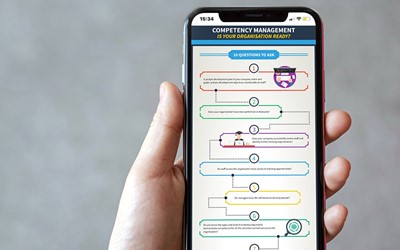How to write effective competency statements
To help you develop the most effective competency statements, whether you’re creating them for the first time, or if you’re rewriting them, it’s important to go back to the basics.
A good question to have in mind is ‘what is the purpose of providing these competency statements?’
Posted 25 May 2022
Components of Competency Definition
Competency statements or definitions as they are often referred to are used to describe a competency required in your chosen situation/environment. A competency definition usually includes:
- A title - often written to identify the context, i.e. Hazard Materials Handling
- A statement - to identify the behavior or capabilities required to perform a task. This should include any conditions that might apply. i.e. Use hazardous materials according to Company health and safety regulations and workplace requirements.
- Some metadata - to organize, sort and reference the definition.
- A level of proficiency - to identify what expertise is required.
The definition should be able to be used on its own, be singular in its expected result, and able to work in combination with others in a competency framework. And each definition requires a unique identifier so it can be reused in many frameworks.
Learning Outcomes Vs Competency Definitions
There is lots of confusion in L&D circles on the difference between learning outcomes and competency definitions. Typically learning outcomes can be made up of a number of competency definitions, indeed some may be frameworks, and they can also include other information which is not competency based, such as academic certification.
Whereas each competency definition should be unique to a single expected behavior or capability. When definitions are collected together into frameworks they typically describe a job function or Job role.
Competency Models
When writing a definition there are a number of models, but all are based around the Action, Instruction, expected Result model (AIR), or STAR, comprising Situation, Task, Action, Result. An action is always a verb, where instruction or tasks are the object of the verb, indicating the actions to be taken to achieve the expected outcome.
Effective and Valid Competency Statements
So, to start writing your competencies so they are effective and valid you need:
- To understand the context of the situation being described;
- The ability to write statements, using verbs, that relate to the level of expertise required;
- Identify your statements as Knowledge, Behavior or Skill; and
- Provide an evaluation method to validate that the statements are effective.
Free eBook: The Pathway to performance
If you’re looking to understand more about the key considerations for implementing a competency tracking framework and how this will benefit your company, please download our Competency Management eBook, in which we share how you can use competency management as the pathway to performance.
And if you would like our help in writing competency definitions, please do get in touch.
Recent Posts
eCom Learning Solutions: Staying ahead in a constantly evolving landscapeIs your work changing, or just your tools? A question for the modern workforce
What is competency? And why it matters in the workplace
Bridging the integrity gap: A proactive approach with eNetEnterprise
Proving Learning Works: Trends Driving Workplace Training in 2025



